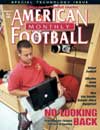AMERICAN FOOTBALL MONTHLY THE #1 RESOURCE FOR FOOTBALL COACHES
Article CategoriesAFM Magazine
|
Virtual Footballby: Jane Musgrave© More from this issue It's the end of a long practice in an even longer week. But despite your best efforts, your quarterback clearly needs more work. He's having a hard time throwing long against the blitz and there's no way he's going to master it without spending a lot more time on the field. Time, however, is one thing you can't give him. Don't panic. Just hand him his virtual reality mask, program it for a rush and send him on his way. Tell him you'll see him in the morning to discuss the computer printout of his results. While such a scenario might seem far-fetched, techno buffs say the use of virtual reality to help train athletes is not more than a nanosecond or two away. "Virtual reality would be the best playbook in the world," says Randy Sinclair, director of sales and marketing for Quick Scout Technologies.....The full article can only be seen by subscribers. Subscribe today!
|
|
|||||||
| HOME |
MAGAZINE |
SUBSCRIBE | ONLINE COLUMNISTS | COACHING VIDEOS |
Copyright 2025, AmericanFootballMonthly.com
All Rights Reserved





